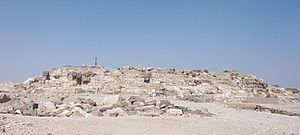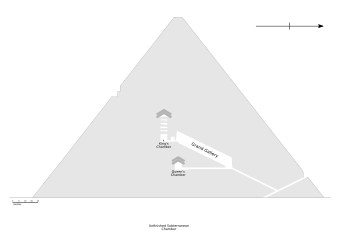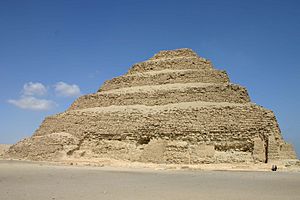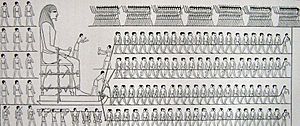Egyptian pyramids facts for kids
The Egyptian pyramids are huge, ancient buildings that were made as tombs for the pharaohs (the kings of ancient Egypt) and their wives. These pyramids were more than just graves. They also showed how powerful the pharaoh was and how connected he was to the gods.
The pyramids show how clever, skilled, and hardworking the ancient Egyptians were. They help us remember a fascinating civilization and give us a peek into the past. By learning about the pyramids, we can understand the beliefs, customs, and achievements of the ancient Egyptians. We can also appreciate their big impact on human history.
Contents
- Why did ancient Egyptians build pyramids?
- When were the pyramids built?
- How many pyramids are there and where are they?
- How did ancient Egyptians build the pyramids?
- Who built the pyramids?
- What's inside the pyramids?
- The pyramids today
- Fun facts about the Egyptian pyramids
- Other pages
- Images for kids
- See also
Why did ancient Egyptians build pyramids?
The ancient Egyptians believed in a life after death, called the afterlife. They thought that when a pharaoh died, his spirit, called the "ka," needed a safe place to live and be looked after. The pyramid was built to protect the pharaoh's body. It also held everything his ka would need in the afterlife, like food, clothes, furniture, and even statues of servants.
The pyramids were also built to impress people. They were meant to show the pharaoh's power and wealth. Their huge size and grand look were a way of saying, "This pharaoh was a very important person!"
When were the pyramids built?
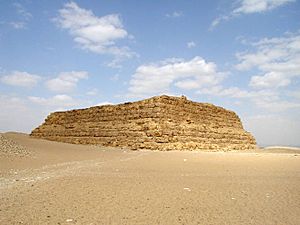
Egyptians built pyramids for a very long time, from about 2700 BC to 1700 BC. That's about 1,000 years! This time is known as the Old Kingdom, the Middle Kingdom, and parts of the New Kingdom.
- Old Kingdom (around 2700-2200 BC): This was the main time for building pyramids. The most famous ones, like the Great Pyramid of Giza, were built then.
- Middle Kingdom (around 2050-1800 BC): Pyramids were still built, but they were often smaller and made from materials that didn't last as long.
- New Kingdom (around 1550-1070 BC): During this time, pharaohs usually chose to be buried in underground tombs in the Valley of the Kings, instead of in pyramids.
Some of the most famous pyramids include:
- The Pyramid of Djoser at Saqqara, built around 2670 BCE.
- The Bent Pyramid and Red Pyramid of Sneferu at Dashur, built around 2612–2589 BCE.
- The Great Pyramid of Khufu at Giza, built around 2589–2566 BCE.
- The Pyramid of Khafre and Pyramid of Menkaure also at Giza, built later in the Old Kingdom.
How many pyramids are there and where are they?
Over 100 Egyptian pyramids have been found. Many are in bad shape or buried under desert sand. Because of this, archaeologists are still finding and studying new pyramid structures.
The most recently discovered pyramid was found in 2008. It belonged to Sesheshet, the mother of Pharaoh Teti.
Almost all of Egypt's pyramids are on the west side of the Nile River. Most of them are grouped together in special areas called pyramid fields. Here are some of the most important ones, listed from north to south:
Abu Rawash
This is where you find Egypt's most northern pyramid, the Pyramid of Djedefre. Djedefre was the son of Khufu, who built the Great Pyramid. This pyramid is mostly ruined today. People once thought it was never finished, but now experts believe it was completed. It was probably about the same size as the Pyramid of Menkaure.
The Great Pyramid of Giza
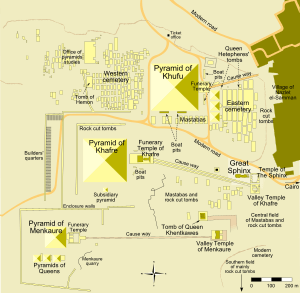
The Great Pyramid of Giza is the biggest and most famous Egyptian pyramid. It was built for Pharaoh Khufu (also called Cheops) around 2580-2560 BC.
- Size: It was originally about 147 meters (481 feet) tall. Today, it's about 139 meters (455 feet) because of erosion. The bottom of the pyramid covers an area as big as about 13 football fields!
- Construction: Experts think the Great Pyramid is made of about 2.3 million stone blocks. Each block weighs about 2.5 to 15 tons!
- Inside: Inside the pyramid are several rooms, including the King's Chamber, the Queen's Chamber, and the Grand Gallery.
The Sphinx
The Sphinx is a huge statue with the body of a lion and the head of a human. It's located close to the Great Pyramid of Giza. People believe it was built around the same time as the pyramids.
- Size: The Sphinx is about 73 meters (240 feet) long and 20 meters (66 feet) high.
- Purpose: The Sphinx is thought to have been built to guard the pyramids. It also showed the pharaoh's power and wisdom.
Zawyet el-Aryan
This site has two pyramids that were never finished. One might belong to Pharaoh Nebka, and the other, called the Layer Pyramid, might be for Pharaoh Khaba.
Abusir
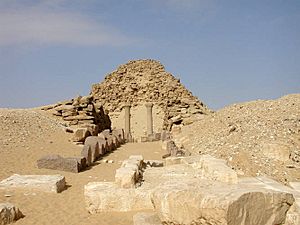
There are 14 pyramids at this site. They were built during the Fifth Dynasty. The pyramids here are not as well-built as the earlier ones from the Fourth Dynasty. They are smaller and made of lower-quality stone.
The main pyramids here are those of Niuserre, Neferirkare Kakai, and Sahure. Most of these pyramids were built with a core of rubble and mudbricks, then covered with limestone.
Saqqara
Important pyramids here include the Pyramid of Djoser. This is thought to be the world's oldest large building made of cut stone. Other pyramids include the Pyramid of Userkaf and the Pyramid of Teti.
The Pyramid of Unas at Saqqara has a well-preserved pathway leading to it. Also at Saqqara is the unfinished pyramid of Djoser's successor, Sekhemkhet, known as the Buried Pyramid. If it had been finished, it would have been bigger than Djoser's pyramid.
South of the main pyramids at Saqqara are smaller, later pyramids. These include the tombs of Pepi I and Pepi II. Most of these are not well preserved.
Dahshur
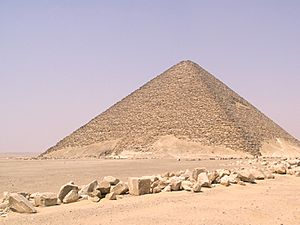
This area is very important for pyramids, almost as much as Giza and Saqqara.
The southern pyramid of Sneferu is called the Bent Pyramid. It was one of the first pyramids meant to have smooth sides. It's unique because it still has a lot of its original smooth outer casing. This shows us how ancient Egyptians wanted their pyramids to look.
A few kilometers north of the Bent Pyramid is the Red Pyramid. This was the first truly successful smooth-sided pyramid. It's also the third-largest pyramid in Egypt, after the pyramids of Khufu and Khafre at Giza.
Meidum
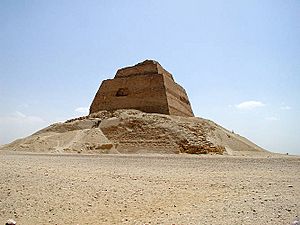
The pyramid at Meidum was also built during the reign of Sneferu. It started as a step pyramid and was later changed into the first "true" smooth-sided pyramid. However, parts of it collapsed a long time ago. Today, it looks like a tower with only three steps visible. The hill it sits on is actually a pile of debris from the collapsed parts of the pyramid.
Lisht
Two major pyramids are found at Lisht: those of Amenemhat I and his son, Senusret I. Senusret I's pyramid is surrounded by the ruins of ten smaller pyramids.
Hawara
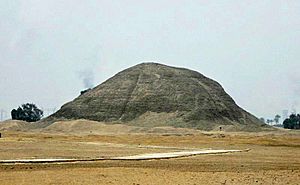
Amenemhat III built a pyramid at Hawara. This pyramid is believed to be his final resting place.
El Lahun
The Pyramid of Senusret II at El Lahun is the southernmost royal pyramid in Egypt. Its builders saved work by using a 12-meter-high natural limestone hill as its base.
El-Kurru
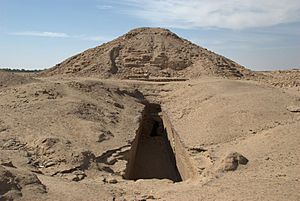
Piye, a king from Kush who became the first ruler of the Twenty-fifth Dynasty, built a pyramid at El-Kurru. He was the first Egyptian pharaoh in centuries to be buried in a pyramid.
Nuri
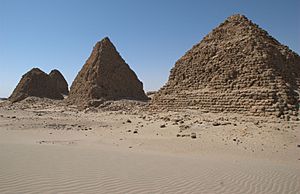
Taharqa, another Kushite ruler, built his pyramid at Nuri. It was the biggest pyramid in that area (North Sudan).
How did ancient Egyptians build the pyramids?
Building the pyramids was a huge job that needed lots of planning, organizing, and hard work. The ancient Egyptians were very skilled engineers and mathematicians. They used their knowledge to design and build these amazing structures.
- Getting the stones: The stone blocks came from nearby quarries. Workers used copper tools, wooden levers, and ropes to cut and move the stones.
- Moving the stones: The stones were moved to the pyramid site on wooden sledges pulled over sand. The Egyptians might have poured water on the sand to make it easier to slide the sledges.
- Lifting the stones: This is one of the biggest mysteries! How did they lift such heavy stones so high? One idea is that they used ramps made of earth and brick. These ramps would have been built higher and higher as the pyramid grew. Workers would have pulled the stones up the ramps using ropes and levers.
Who built the pyramids?
For a long time, many people thought slaves built the pyramids. However, new discoveries show that skilled workers built them. These workers were paid for their labor. They lived in organized camps near the pyramid sites and were given food, housing, and medical care.
The workers were put into teams. Each team had a specific job, like cutting stones, moving them, or laying them. They worked hard and were proud of what they built.
What's inside the pyramids?
The inside of a pyramid is like a maze with rooms, hallways, and shafts. These were made to protect the pharaoh's body and belongings from robbers.
- King's Chamber: This is the main room where the pharaoh's sarcophagus (a stone coffin) was placed.
- Queen's Chamber: This room is smaller than the King's Chamber. Its exact purpose is still a bit of a mystery.
- Grand Gallery: This is a long, sloping hallway that leads to the King's Chamber.
- Air Shafts: These are narrow shafts that go from the rooms to the outside of the pyramid. Their purpose is not fully known. Some think they were for air or for religious reasons.
The pyramids today
Today, the Egyptian pyramids are one of the most popular places to visit in the world. Millions of people travel to Egypt each year to see these amazing structures and learn about the ancient Egyptians.
The pyramids are also a place for ongoing research. Archaeologists are still finding new information about the pyramids and the people who built them.
Fun facts about the Egyptian pyramids
- The oldest known Egyptian pyramids are found at Saqqara, near Memphis.
- The first pyramid we know about was built for Pharaoh Djoser in the 3rd Dynasty.
- Several of the Giza pyramids are among the largest buildings ever made.
- The Pyramid of Khufu is the biggest Egyptian pyramid. It's the only one of the Seven Wonders of the Ancient World that is still standing today.
- The sides of the Great Pyramid of Giza line up almost perfectly with north, south, east, and west.
- The ancient Egyptians used a special measurement called the "royal cubit" to build the pyramids.
- Some pyramids might still have secret rooms and passages that haven't been found yet.
- The pyramids were originally covered in smooth, white limestone. This would have made them shine brightly in the sun!
- The pyramid shape is thought to represent the first mound of earth that ancient Egyptians believed the world was created from.
- One idea is that pyramids were like "resurrection machines." Egyptians believed a dark area in the night sky was a gateway to the heavens. One narrow shaft in the Great Pyramid points right to the center of this sky area. This suggests the pyramid might have been built to magically send the pharaoh's soul to the gods.
Other pages
Images for kids
See also
 In Spanish: Pirámides de Egipto para niños
In Spanish: Pirámides de Egipto para niños


